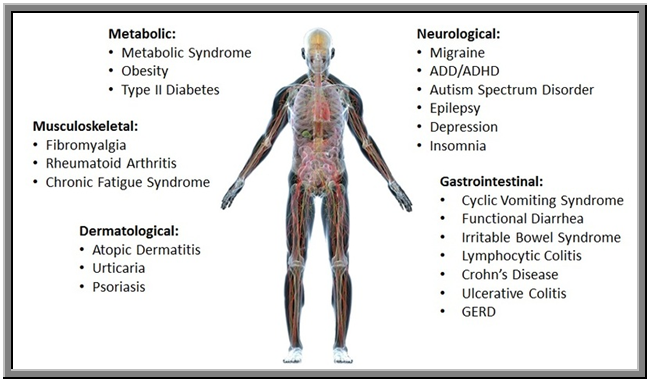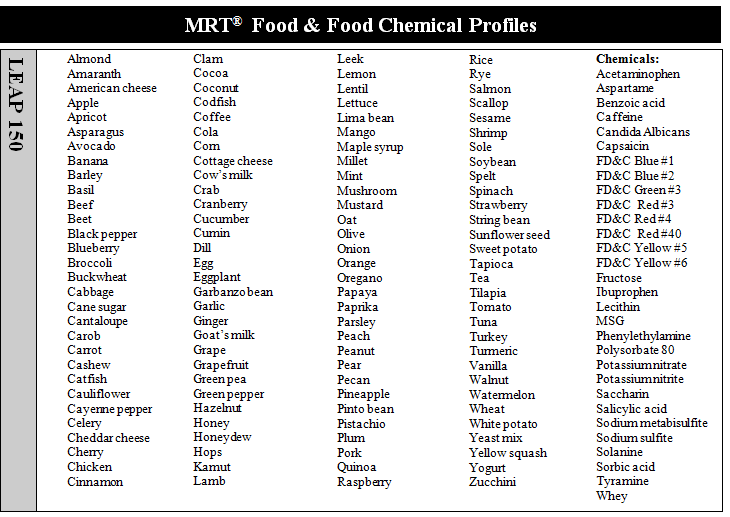I feel it is important to do a food sensitivity test like the MRT – the mediator release test. Food sensitivities affect 75% of the population, so it makes sense to test for food sensitivities. They can cause serious health issues and weight gain.I think the MRT is the best food sensitivity test. I was shocked at my test results and feel so much better eliminating the foods to which I am sensitive.
Food Sensitivities testing is essential to stop the diet and food-induced inflammation in the body and the many undesirable symptoms and health conditions that come from eating foods to which we are sensitive. When the body’s immune system is constantly launching a response to foods, it drains the immune system’s precious resources and your energy.

Most alternative practitioners try to measure food sensitivities with an IgG test but this is only one type of immune reaction and research has shown it is not an accurate test (click here to download research). IgG is a one mechanism of an immune response that may or may not release the mediators that cause symptoms. There may also be non-immune responses such as a histamine intolerance or lectin damage to the intestinal cells. There may also be intestinal allergies (IgE) which will not get picked up on any test – even an IgE allergy test.
Mediator Release Testing (MRT) is the primary food sensitivity testing I use when it appears a person’s symptoms are caused by a foods they are eating which causes a peripheral immunocyte response. That is a fancy way of saying that there is an immune reaction that can be measured in the blood and we assume the cause is food antigens. These reactions trigger symptoms such as migraines, fibromyalgia, and IBS. We use the test results as a road map for an individualized anti-inflammatory diet. (what is one person’s inflammatory diet may be an inflammatory provoking diet for another). Then once symptoms are greatly improved after several weeks we add in untested foods as an oral challenge.
What is a Food Sensitivity?
A food sensitivity, also called a food intolerance, is caused by an inability to digest a food. Symptoms are “delayed onset”, where symptoms do not appear for hours or even days, making them difficult to determine. Food sensitivities are not fixed and can come and go during the course of one’s life. Just because you’re diagnosed with a food sensitivity one year does not mean it will hold true for the rest of your life. Typically, when people heal their gut and adrenal glands, many food sensitivities disappear. But it makes sense to avoid foods that are bothersome until other health issues can be addressed.
The Problem with Food Elimination Diets
The only problem food elimination diets is that you can only eliminate so many foods at one time. There are so many other foods to which you could be sensitive – even foods considered very healthy. Many meals contain 30 or more foods and it is hard to pinpoint with a food elimination and challenge all the foods that could be causing problems.
And then there are people who cannot stick to a food elimination challenge. I’ve done them myself and it is incredibly difficult. An MRT solves all these problems.
I think an MRT is a great place to begin doing a food elimination diet. After you eliminate foods and see what symptoms disappear, you can reintroduce foods and see how you feel. It’s a great tool to begin listening to your body and seeing how foods dramatically affect your health.
What does the MRT Rest For?
The MRT tests for 150 different foods and food chemicals – additives that are added to processed foods. It even tests for caffeine! Who knew that your cup of tea could be causing some of your health issues? Here is the complete list of foods the MRT tests.

Is MRT Accurate?
A blinded peer-reviewed scientific study showed MRT to have the highest level of accuracy of any food sensitivity blood test. (94.5% sensitivity and 91.8% specificity).
The Difference Between MRT and Other Tests
There are several food sensitivity tests available. They are IgG (ELISA or RAST), ALCAT, and LRA. Without understanding some basics, it is impossible to understand how one is superior to the others and how they compare.
Food sensitivities make a person feel sick because there is a release of chemicals called mediators (such as histamines, prostaglandins, cytokines etc) from white blood cells. The release of mediators is typically triggered by an immune mechanism (IgA, IgG, IgM, Complement). But it is the release of the mediators that makes one feel sick, not the immune mechanisms.
Food sensitivity is a very complex reaction by our immune system. There are many different cells that have different profiles of mediators, many mechanisms that cause mediators to be released, and of course, many different mediators. The thing that makes food sensitivities complicated is that there are various ways the immune system can respond to hypersensitivity. Because there are different ways the immune system can respond, there are different approaches researchers have tried to identify reactive foods and chemicals.
ELISA IgG: This test quantifies how much IgG you are producing to a specific food, with the assumption that high levels of IgG are only a bad thing. There is a specific type of immune reaction called Type 3 hypersensitivity that can involve IgG or another antibody called IgM. When IgG is involved in triggering mediator release, this testing will be very helpful. Unfortunately, there are limitations of IgG testing:
- High levels of IgG can be bad (causing an immune response and a release of mediators, thereby symptoms). Or high levels of IgG can be protective against a more serious IgE allergy. So just because you have high IgG levels may not mean that the food is a problem.
- IgG only plays a minor role in IBS, migraine, fibromyalgia. Instead, research shows that Type 4 hypersensitivity is the primary type of reaction. Type 4 hypersensitivity doesn’t involve IgG or any other antibodies.
- IgG testing cannot identify reactions to chemicals like food additives. It is clearly documented that food chemicals play a very important role in provoking symptoms in many conditions. If you cannot identify these reactions, you could very well be missing very important information that can impact health.
There are a number of advantages of MRT over any form of IgG testing. MRT is an endpoint test, meaning that all the immune-based adverse reactions that end up causing a mediator release in the blood will be identified. So MRT does this without caring about the mechanism (such as IgG). In fact, MRT is able to take into account the actions of all mechanisms, whether they are antibodies or other because all of them ultimately cause white blood cells to release mediators. MRT is able to account for a much wider array of reactions than the relatively simple IgG testing. Overall MRT is more accurate and useful clinically.
The ALCAT Test: The ALCAT test was invented and patented by the same person who invented and patented MRT, Dr Mark Pasula. The two technologies are similar, yet separately patented, which means there is a unique difference. The main difference between the two tests is in terms of accuracy and reliability. Side by side studies have show MRT to be more accurate (higher sensitivity and specificity) and to have higher split sample reproducibility than ALCAT.
How Does MRT Work?
MRT is an indirect method of accurately measuring mediator release. MRT does this by measuring changes in the liquids to solids ratio of your blood after your blood has been exposed and incubated with the test substance. It accounts for all reactions by your immune cells. This is done as an indicator that your immune cells have released chemical mediators such as histamines, cytokines and others. Significant reactions are broken into either Reactive (Red), Moderately Reactive (yellow) or insignificant reactions (Green). All measurements are made using the most accurate method of measurement (Ribbon technology) currently available.
How do We Interpret the Results?
Based on your MRT results, I give you a list of the foods you cannot eat. Together we will develop a diet where you only eat the lowest reactive foods for 7 days or so. We expect a significant reduction in symptoms during this time. Then we will add in slightly more reactive foods (but still low reactive) over time. Then the third phase if there is continued improvement in health we add in more foods.
The end result is that you get to experience how food can affect your health. You’ll gain a life-long tool of realizing that the digestive symptoms, weight gain or sinus issues you are experiencing were from a food you recently ate. From our nutritional consults, you will learn how to identify problematic foods by an elimination and then provocation challenge.









